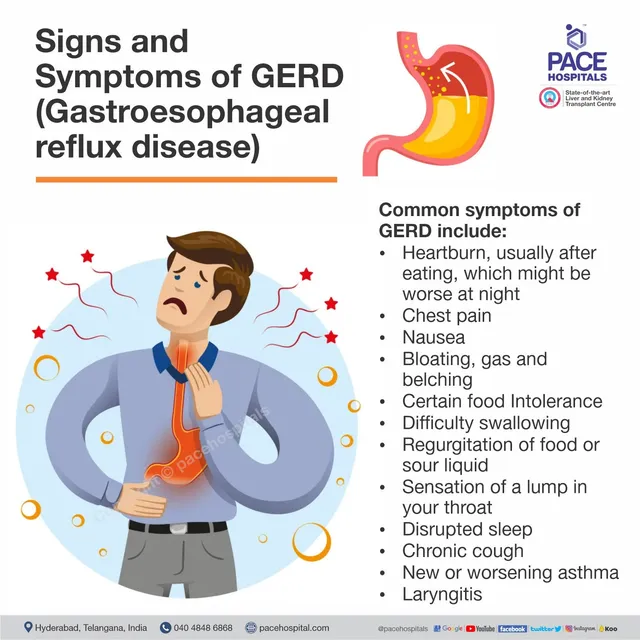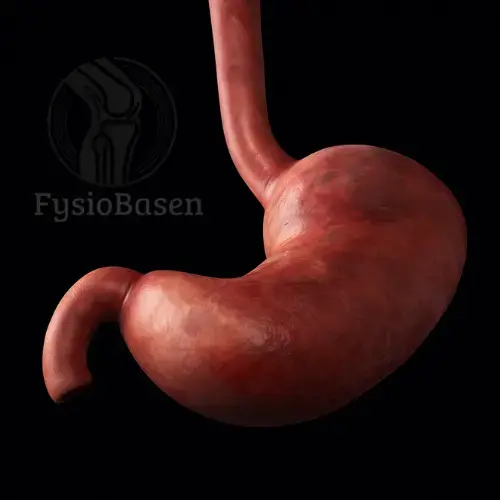Gastroesophageal Reflux Disease (GERD)
- Fysiobasen

- Sep 9
- 7 min read
Gastroesophageal reflux disease (GERD), also called esophagitis, is a complex condition that can cause serious complications. The condition is caused by the backflow (reflux) of stomach contents into the esophagus, leading to bothersome symptoms at least twice a week. Reflux may be triggered by infections, chemical irritation, physical stress (such as radiation or a nasogastric tube), and can result in inflammation and irritation of the esophagus. This typically causes heartburn, belching, sore throat, and several other symptoms¹²³⁴.

Important Distinction
It is important to understand that heartburn is not the same as GERD, but it is the most common symptom of this condition¹. GERD is the most frequent cause of heartburn, though other conditions can also lead to similar complaints⁴.
Although GERD is very common in the population, the disease is rarely life-threatening. However, it can significantly reduce quality of life and affect daily activities and work capacity⁵. GERD can occur in both infants and children—most infants outgrow it, while children otherwise present with the same symptoms as adults².
Prevalence
GERD is the most common gastrointestinal diagnosis made in general practice or outpatient clinics. It is estimated that 14–20% of adults are affected, though these numbers are mainly based on self-reported chronic heartburn⁴. Studies have shown that GERD may be completely asymptomatic in 24% of patients with difficult-to-treat asthma⁸.
The condition is most often seen in:
Patients with asthma
Individuals aged 45–54 years
Individuals with BMI > 25 and concurrent asthma or COPD
Clinical Presentation

Pain in the lower part behind the sternum is typical of GERD and is often described as heartburn or indigestion. The pain may also be experienced as gripping, squeezing, or burning behind the sternum²³.
Symptoms often occur when lying down, after meals, or when bending forward, and are usually worse at night. It is important to note that symptoms of GERD can often be mistaken for angina or myocardial infarction—this should always be assessed by a physician. GERD is rarely triggered by physical activity and is usually relieved by antacids, which can help differentiate it from heart disease.
Chest pain originating from the upper gastrointestinal tract may radiate from the chest backward to the upper back, or to areas between or beneath the shoulder blades (T10–L2).
Common symptoms:
Heartburn
Bitter or sour taste at the back of the throat
Sensation of a “lump” in the throat
Bloating or abdominal discomfort
Gas
Chronic cough
Sensation of food sticking behind the sternum or in the throat
Nausea after meals
Burning sensation starting at the lower sternum and spreading up toward the throat
Intense, sharp pain behind the sternum that may radiate to the back
Less common symptoms:
Swallowing difficulties (dysphagia)
Hiccups
Hoarseness or voice changes
Sore throat
Wheezing
Ear pain
Associated Conditions and Risk Factors

Individuals with a history of alcohol abuse, liver cirrhosis, peptic ulcer, esophageal varices, esophageal cancer, or long-term use of NSAIDs (anti-inflammatory painkillers) are at greater risk for GERD and should be thoroughly examined to rule out serious conditions.
Typical risk factors for GERD include:
Hypotonia (reduced tension) of the lower esophageal sphincter
Reduced esophageal peristalsis
Abdominal obesity
Increased compliance of the hiatus (diaphragmatic canal)
Increased gastric acid production
Delayed gastric emptying
Pregnancy
Diseases such as scleroderma
Hiatal hernia²
Pharmacological Treatment
Antacids: Neutralize stomach acid but do not reduce its production. Available over-the-counter (e.g., Mylanta, Maalox, Tums, Rolaids).
Histamine-2 receptor blockers: Reduce gastric acid production. Some are available over-the-counter, such as Pepcid, Zantac, Tagamet, and Axid.
Proton pump inhibitors (PPIs): The most potent acid-suppressing agents, they stop gastric acid production rather than neutralizing it. Some (Prilosec/omeprazole, Zegerid) are available over-the-counter, while others (Prevacid, Protonix, Nexium, Aciphex) require a prescription. Long-term use may cause side effects and mask serious disease. Patients using these medications should consult a physician if they experience headache, constipation, diarrhea, abdominal pain, or dizziness.
Practical note for physiotherapists: It is important that physiotherapists are aware of their patients’ medications and report to a physician if patients experience headache, gastrointestinal complaints, dizziness, constipation, or diarrhea.
Diagnostic Tests and Laboratory Examinations
In most cases, further investigation is not necessary for mild GERD symptoms. However, if complaints are severe, persistent despite treatment, or recurrent, further evaluation is warranted—especially in cases of dysphagia, odynophagia, bleeding, weight loss, anemia, or suspected Barrett’s esophagus³⁴.
The most common examinations include:
Gastroscopy (esophagogastroduodenoscopy):
A small camera tube is inserted through the mouth to examine the mucosa of the esophagus, stomach, and upper small intestine⁵ ⁹.
Barium swallow:
The patient drinks barium sulfate before X-ray, providing clear images of the upper gastrointestinal tract¹⁰.
Continuous pH monitoring in the esophagus:
A thin tube is inserted into the esophagus to measure acidity (pH) over time⁵.
Manometry:
Measurement of esophageal pressure using a thin tube passed through the nose or mouth⁵.
Causes and Triggers (Etiology)
The lower esophageal sphincter (LES) is a ring of muscle fibers that prevents stomach contents from flowing back into the esophagus. If the LES functions poorly, food, liquid, and gastric acid can reflux into the esophagus and damage the mucosa³.
Key risk factors:
Overweight
Smoking
Alcohol use
Certain medications
LES dysfunction (weakened sphincter)
Medications that may cause or worsen GERD:
NSAIDs (e.g., Ibux, Motrin, Aleve)
Anticholinergics (Bentyl)
Beta blockers (Toprol XL)
Bronchodilators (Advair)
Calcium channel blockers (Norvasc)
Hormone therapy (progesterone)
Sedatives (Valium, Xanax)
Tricyclic antidepressants (Doxepin)
Systemic Effects
Musculoskeletal system:
Untreated ulcers may alter muscle activity and spinal movements. Patients may experience musculoskeletal complaints, such as in the thoracic spine or between the shoulder blades, which are actually due to GERD. Physiotherapists should always inquire about gastrointestinal symptoms when assessing chest or mid-back pain.
Teeth and oral cavity:
GERD can cause permanent acid damage to the back of the teeth. Typical symptoms include vomiting, sour taste, belching, heartburn, abdominal pain, and morning discomfort. Oral symptoms may include burning mouth, tooth sensitivity, loss of bite height, and cosmetic dental changes¹¹.
Lungs and airways:
Gastric acid entering the airways can cause bronchial constriction and increased airway irritability. Acid triggers nerve and inflammatory reactions leading to mucosal swelling and asthma exacerbation. This can increase asthma severity and respiratory symptoms¹².
Gastrointestinal tract:
GERD is a major risk factor for Barrett’s esophagus—a precancerous condition of the esophagus. In Barrett’s, normal squamous epithelium is replaced with columnar epithelium, which increases the risk of esophageal adenocarcinoma¹³. Chronic GERD is therefore a major cause of this cancer².
Surgical Treatment
If lifestyle changes and medications do not provide sufficient symptom relief, surgery may be considered.
Nissen fundoplication:
A surgical procedure in which the upper part of the stomach is wrapped around the lower esophagus to create an antireflux barrier. Previously very common, it is less frequently used today due to variable results and dissatisfied patients⁴.
Possible side effects include:
Severe swallowing difficulties
Inability to belch
Increased gas in the stomach
Diarrhea
Bloating
Abdominal pain
Constipation
Fysioterapi og fysisk behandling ved GERD

Physiotherapy and Physical Treatment in GERD
Patients with GERD may sometimes visit the clinic with atypical symptoms from the head and neck region, without typical complaints such as heartburn¹. It is important that the physiotherapist is aware of pain radiation from the esophagus. In such unclear cases, the therapist must always ask whether the patient has experienced swallowing difficulties, speech problems, chronic dry cough, or similar symptoms.
Some patients come to physiotherapy for other complaints but also have known GERD. In these cases, it is important that the physiotherapist considers this when choosing treatment, especially regarding positioning and lifestyle advice.
When treating a patient with GERD:
Help the patient implement dietary and lifestyle changes related to diet and physical activity
Provide information and guidance on necessary lifestyle modifications
Teach correct positioning:
Avoid lying exercises immediately after meals
Advise sleeping on the left side
Avoid lying on the right side, as this increases the risk of acid in the esophagus
Elevating the head of the bed reduces reflux and abdominal pressure
Shaker’s Head-Lift Exercise
Research shows that the Shaker exercise, developed by Dr. Reza Shaker, can improve swallowing function in patients with dysphagia, hiatal hernia, and GERD. The exercise strengthens the muscles of the upper esophageal sphincter (UES) and may help restore normal swallowing and reduce aspiration risk.
How to perform the Shaker exercise:
Lie on your back on a firm surface without a pillow, arms at your sides
Breathe calmly throughout the exercise
Lift and hold:
Lift your head to look at your toes, keeping shoulders against the surface
Hold for 1 minute, then relax
Repeat twice more, resting 1 minute between holds
Lift and lower:
Lift your head toward your chest (like a “sit-up” for the neck), then lower slowly
Repeat 30 times
Relax afterwards
Lifestyle Changes
Changing diet and daily habits, and avoiding foods and drinks that trigger symptoms, can significantly reduce GERD complaints. Certain foods and beverages are known to worsen heartburn and reflux and should be avoided, along with other individual triggers.
Foods and drinks that often increase symptoms:
Alcohol
Caffeine
Carbonated beverages
Chocolate
Citrus fruits and juices
Tomato products
Spicy or fatty foods
Milk and high-fat dairy products
Peppermint, spearmint
Tobacco (reduces saliva production, important for clearing acid from the esophagus)
Lifestyle and eating habits that help with GERD:
Do not smoke
Do not lie down within 2–3 hours after a meal, especially not flat
Avoid tight clothing or belts around the waist/chest
Avoid bending or exercising right after meals
Eat small, frequent meals
Reduce stress
Elevate the head of the bed about 15 cm using a wedge or by raising the whole bed (not just pillows)
Weight reduction helps if overweight
Chewing sugar-free gum after meals increases saliva production and neutralizes acid
Keep a food diary to identify and avoid individual triggers
Differential Diagnoses
The following conditions may produce symptoms resembling GERD and should be considered in the evaluation:
Coronary heart disease
Gallbladder disease
Cancer of the stomach or esophagus
Peptic ulcer
Esophageal motility disorders
Eosinophilic, infectious, or drug-induced esophagitis
References
Goodman CC, Fuller KS. Pathology: Implications for the Physical Therapist. 3rd ed. St. Louis: Saunders Elsevier; 2009.
Goodman C, Snyder TE. Differential Diagnosis for Physical Therapists: Screening for Referral. 4th ed. Philadelphia: WB Saunders; 2003.
National Center for Biotechnology Information. Gastroesophageal reflux disease. Available from: http://www.ncbi.nlm.nih.gov/pubmedhealth/PMH0001311/
Kahrilas PJ. Gastroesophageal Reflux Disease. N Engl J Med. 2006;359(16):1700–1707.
Medical College of Wisconsin. Gastroenterology & Hepatology. Available from: http://www.mcw.edu/gastrohep.htm
HealthGuru. Understanding GERD (GERD #1). Available from: https://www.youtube.com/watch?v=o8iShP84HP4
Mayo Clinic. Heartburn, Acid Reflux, GERD. Available from: https://www.youtube.com/watch?v=TdK0jRFpWPQ
Bor S, Kitapciogle G, Solak ZA, et al. Prevalence of GERD in asthma and COPD patients. JGHF. 2009;25:309–313.
NCBI. EGD – esophagogastroduodenoscopy. Available from: http://www.nlm.nih.gov/medlineplus/ency/article/003888.htm
Harvard Health. Barium Swallow (Upper GI Series). Available from: http://www.health.harvard.edu/diagnostic-tests/barium-swallow.htm
Ali DA, Brown RS, Rodriguez LO, et al. Dental erosion caused by silent GERD. JADA. 2002;133(6):734–737.
Böcskei C, Viczián M, Böcskei R, Horváth I. GERD and asthmatic cough. Lung. 2005;183(1):53–62.
Veugelers PJ, Porter GA, Guernsey DL, Casson AG. Obesity and lifestyle risk factors for GERD and esophageal adenocarcinoma. Dis Esophagus. 2006;19(5):321–328.
Mayo Clinic. Anti-reflux Surgery, Fundoplication. Available from: https://www.youtube.com/watch?v=X840-6PyO4c
Padwal T, Gurudut P, Hajare S. Effect of Shaker’s exercise with kinesio taping in GERD patients. Int J Med Res Health Sci. 2018;5(10):170–178.
Stevens L. Chronic GERD and its effect on laryngeal visualization and intubation. AANA J. 2002;70(5):373–375.
Logemann JA, Rademaker A, Pauloski BR, et al. Shaker Exercise vs Traditional Therapy. Dysphagia. 2009;24(4):403–411.









